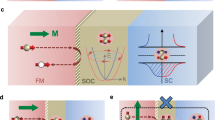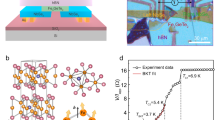Abstract
Interfaces between materials with differently ordered phases present unique opportunities to study fundamental problems in physics. One example is the interface between a singlet superconductor and a half-metallic ferromagnet, where Cooper pairing occurs between electrons with opposite spin on the superconducting side, whereas the other exhibits 100% spin polarization. The recent surprising observation of a supercurrent through half-metallic CrO2 therefore requires a mechanism for conversion between unpolarized and completely spin-polarized supercurrents. Here, we suggest a conversion mechanism based on electron spin precession together with triplet-pair rotation at interfaces with broken spin-rotation symmetry. In the diffusive limit (short mean free path), the triplet supercurrent is dominated by inter-related odd-frequency s-wave and even-frequency p-wave pairs. In the crossover to the ballistic limit, further symmetry components become relevant. The interface region exhibits a superconducting state of mixed-spin pairs with highly unusual symmetry properties that open up new perspectives for exotic Josephson devices.
This is a preview of subscription content, access via your institution
Access options
Subscribe to this journal
Receive 12 print issues and online access
$209.00 per year
only $17.42 per issue
Buy this article
- Purchase on Springer Link
- Instant access to full article PDF
Prices may be subject to local taxes which are calculated during checkout






Similar content being viewed by others
References
Chakhalian, J. et al. Magnetism at the interface between ferromagnetic and superconducting oxides. Nature Phys. 2, 244–248 (2006).
Keizer, R. S. et al. A spin triplet supercurrent through the half-metallic ferromagnet CrO2 . Nature 439, 825–827 (2006).
Volkov, A. F., Bergeret, F. S. & Efetov, K. B. Odd triplet superconductivity in superconductor-ferromagnet multilayered structures. Phys. Rev. Lett. 90, 117006 (2003).
Asano, Y., Tanaka, Y. & Golubov, A. A. Josephson effect due to odd-frequency pairs in diffusive half metals. Phys. Rev. Lett. 98, 107002 (2007).
Eschrig, M., Kopu, J., Cuevas, J. C. & Schön, G. Theory of half-metal/superconductor heterostructures. Phys. Rev. Lett. 90, 137003 (2003).
Tanaka, Y. & Golubov, A. A. Theory of the proximity effect in junctions with unconventional superconductors. Phys. Rev. Lett. 98, 037003 (2007).
Eschrig, M. et al. Symmetries of pairing correlations in superconductor-ferromagnet nanostructures. J. Low Temp. Phys. 147, 457–476 (2007).
Tokuyasu, T., Sauls, J. A. & Rainer, D. Proximity effect of a ferromagnetic insulator in contact with a superconductor. Phys. Rev. B 38, 8823–8833 (1988).
Sigrist, M. & Ueda, K. Phenomenological theory of unconventional superconductivity. Rev. Mod. Phys. 63, 239–311 (1991).
Kopu, J., Eschrig, M., Cuevas, J. C. & Fogelström, M. Transfer-matrix description of heterostructures involving superconductors and ferromagnets. Phys. Rev. B 69, 094501 (2004).
Anderson, P. W. Theory of dirty superconductors. J. Phys. Chem. Solids 11, 26–30 (1959).
Abrikosov, A. A. & Gor’kov, L. P. Superconducting alloys at finite temperatures. Zh. Eksp. Teor. Fiz. 36, 319–320 (1959); Sov. Phys. JETP 9, 220–221 (1959).
Braude, V. & Nazarov, Yu. V. Fully developed triplet proximity effect. Phys. Rev. Lett. 98, 077003 (2007).
Buzdin, A. I., Bulaevskii, L. N. & Panyukov, S. V. Critical-current oscillations as a function of the exchange field and thickness of the ferromagnetic metal (F) in an S–F–S Josephson junction. Pis’ma Zh. Eksp. Teor. Fiz. 35, 147–148 (1982); Sov. Phys. JETP Lett. 35, 178–180 (1982).
Larkin, A. I. Vector pairing in superconductors of small dimensions. Pis’ma Zh. Eksp. Teor. Fiz. 2, 205–209 (1965); Sov. Phys. JETP Lett. 2, 130–133 (1965).
Lewis, S. P., Allen, P. B. & Sasaki, T. Band structure and transport properties of CrO2 . Phys. Rev. B 55, 10253–10260 (1997).
Acknowledgements
The authors would like to thank J. Kopu and G. Schön for important contributions, A. Posazhennikova for comments on the manuscript, U. Rüdiger for discussions on interface properties of ferromagnets, and R. Keizer and T. Klapwijk for communications in relation to ref. 2. T.L. acknowledges financial support from the Alexander von Humboldt Foundation. M.E. acknowledges the hospitality of the Aspen Center for Physics.
Author information
Authors and Affiliations
Contributions
M.E. and T.L. shared equal responsibility for all aspects of this project.
Corresponding authors
Supplementary information
Supplementary Information
Supplementary Information, Supplementary Fig 1 and Fig 2 (PDF 142 kb)
Rights and permissions
About this article
Cite this article
Eschrig, M., Löfwander, T. Triplet supercurrents in clean and disordered half-metallic ferromagnets. Nature Phys 4, 138–143 (2008). https://doi.org/10.1038/nphys831
Received:
Accepted:
Published:
Issue Date:
DOI: https://doi.org/10.1038/nphys831
This article is cited by
-
Long-range skin Josephson supercurrent across a van der Waals ferromagnet
Nature Communications (2023)
-
Direct observation of a superconducting vortex diode
Nature Communications (2023)
-
Anomalous Josephson coupling and high-harmonics in non-centrosymmetric superconductors with S-wave spin-triplet pairing
npj Quantum Materials (2022)
-
Magnon-cooparons in magnet-superconductor hybrids
Communications Materials (2022)
-
Electronic materials with nanoscale curved geometries
Nature Electronics (2022)



